Stay ahead of the curve and optimize your digital PR efforts with our data-backed Digital PR Statistics 2024 report. Gain valuable insights into the evolving strategies, emerging technologies, and key performance indicators driving successful digital PR campaigns.

Digital PR is a game-changing aspect of modern public relations that focuses on promoting brands, products, or services across various digital channels. With its ability to reach a wider audience and create meaningful engagement, Digital PR has become a go-to strategy for companies looking to stay ahead of the competition.
To see if digital PR is worth the hype, we have analyzed relevant statistics that provide insights into audience behavior, engagement rates, and overall impact.
According to data, the worldwide PR market is valued at over $106.93 billion, and it is expected to grow at a CAGR of 6% over the next four years, reaching $144.28 billion by 2028.
In addition, research indicates that the most promising areas for expansion in the realm of public relations firms are “Strategic communication & PR consultancy,” ranked highest at 25%.
“Social media & digital communications” comes in second at 14%, while “Issues & crisis management” and “Change management” tie for third place at 13%. “Digital strategy” rounds out the list at 11%.
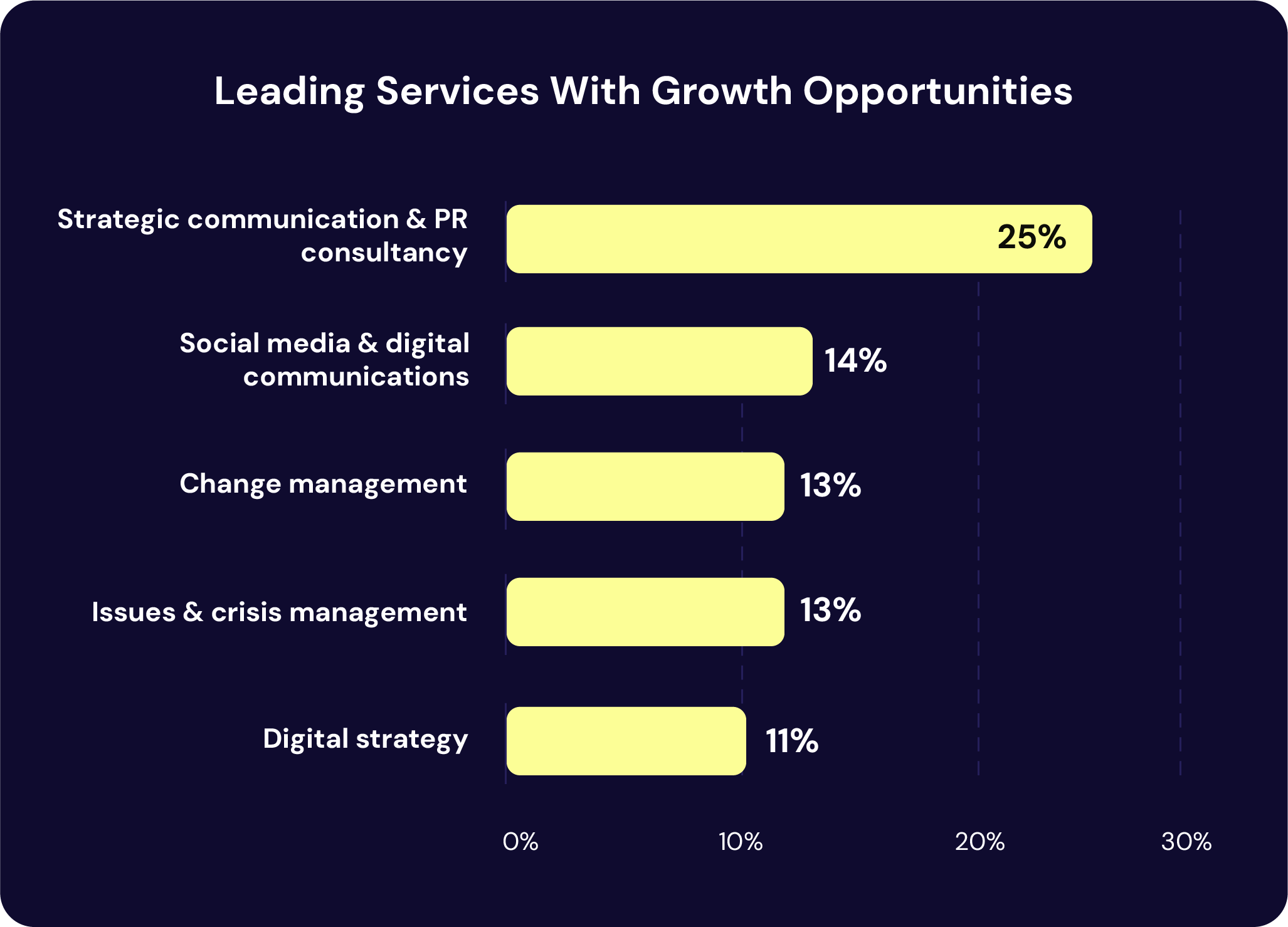
Digital PR strategies are becoming increasingly important as more and more businesses look to establish their online presence.
These strategies involve using various digital channels to reach out to target audiences, build brand awareness, and generate positive publicity.
Media lists are essential for digital PR campaigns to identify and target relevant journalists and media outlets, increasing the chances of securing media coverage and reaching a wider audience.
Notably, 68% of digital PR pros rely on traditional spreadsheet software such as Microsoft Excel or Google Sheets for this purpose.
Meanwhile, 64% utilize dedicated PR software like Muck Rack, suggesting a growing trend in adopting specialized platforms designed to streamline public relations tasks.
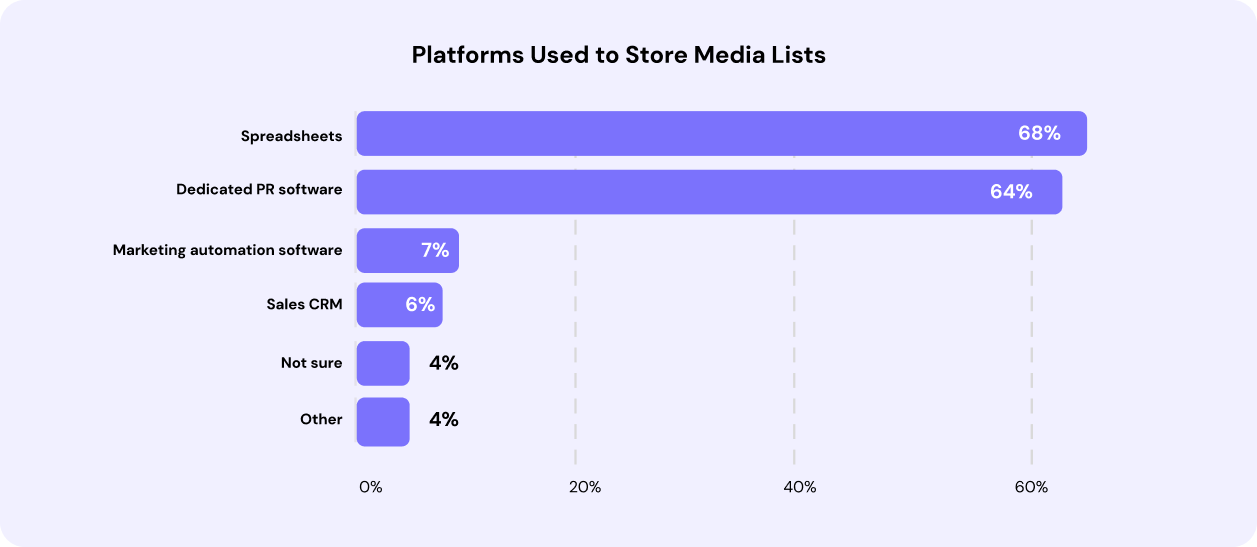
Another important strategy for securing media coverage through a pitch is the subject’s relevance to the journalist. According to 33% of digital PR pros, tailoring pitches to align with the journalist’s beat or interests is essential for capturing their attention and increasing the likelihood of coverage.
Additionally, 20% recognize the importance of a prior relationship with the reporter and the need for customization and personalization in pitches.
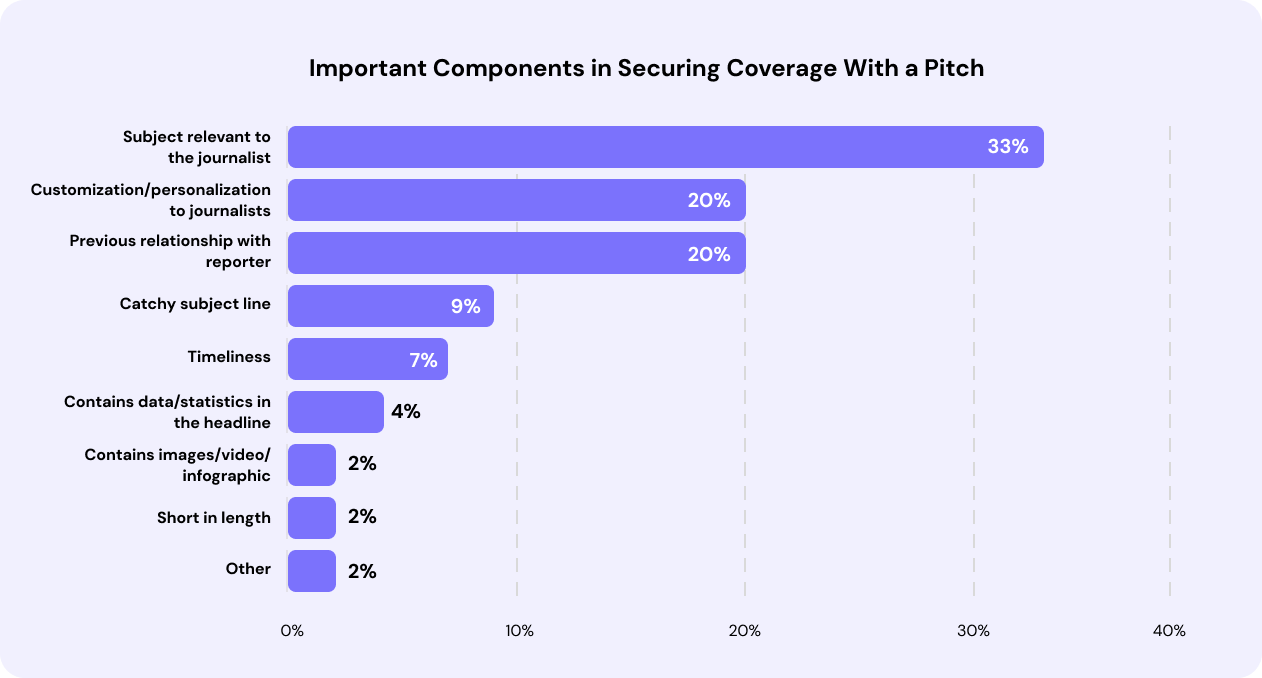
When it comes to pitching journalists, individual one-on-one emails emerge as the overwhelmingly preferred channel, with a significant 89% expressing its effectiveness. This highlights the enduring importance of personalized communication in public relations.
On the other hand, while social media platforms play a role in media outreach, they lag behind email in terms of effectiveness, with Twitter at 18%, LinkedIn at 15%, and Facebook at 4%.
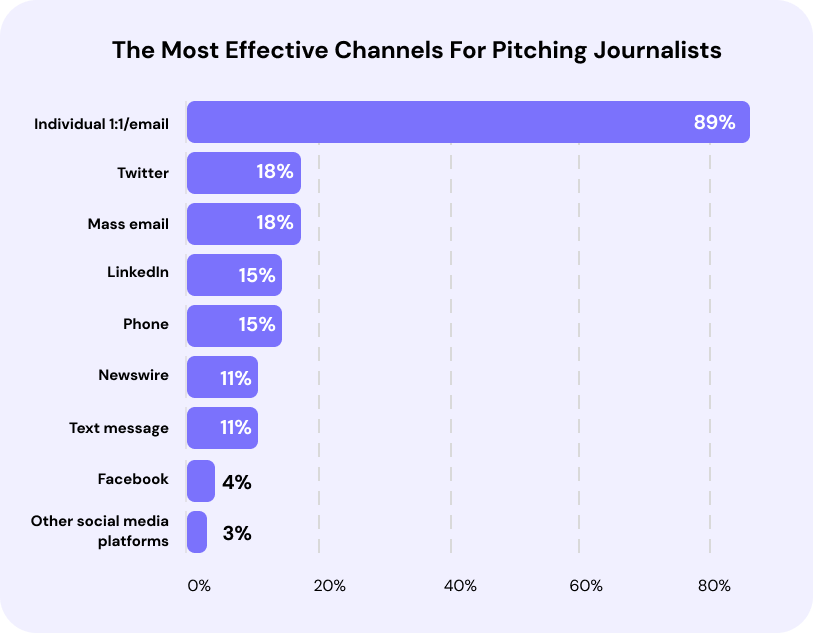
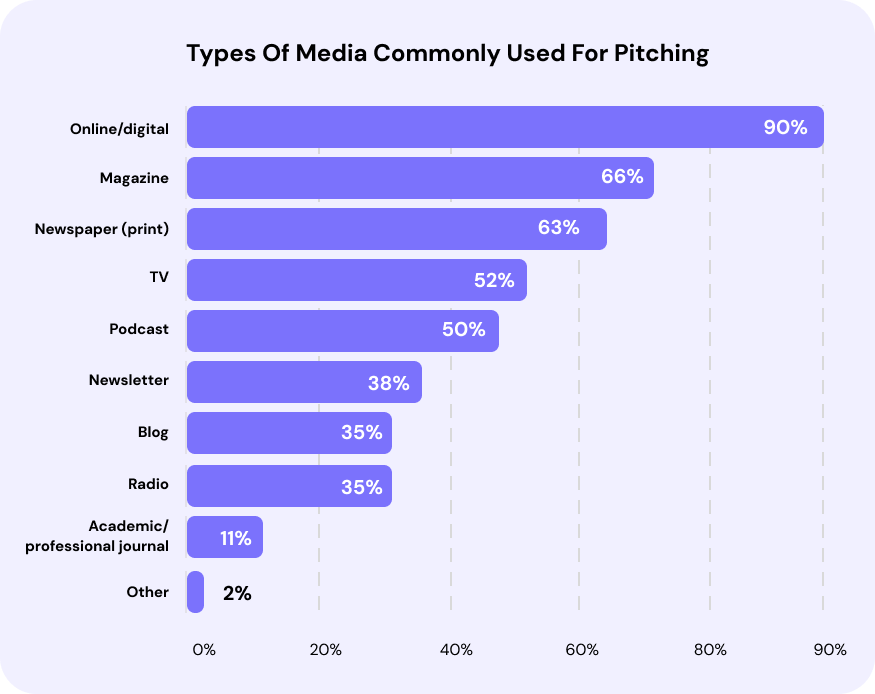
When pitching a digital PR campaign to the media, several types of media are commonly used.
Online and digital platforms emerge as the dominant category, with an overwhelming 90% indicating their common use for pitching.
Magazines and newspapers, though traditional forms of media, continue to hold substantial relevance, with 66% and 63%, respectively.
Television and podcasts follow closely, with 52% and 50% of respondents recognizing their prominence in media pitching strategies.
To make a splash in the media world, there are a variety of effective approaches to finding and connecting with the right journalists.
A predominant 83% rely on media databases, emphasizing the widespread use and effectiveness of specialized tools designed for this purpose.
Google search follows closely as a significant method, with 59% of respondents utilizing the search engine to find suitable journalists.
Additionally, personal contact lists prove valuable, with half of the respondents (50%) indicating their reliance on existing connections in the industry.
Social media platforms are also employed, albeit to a slightly lesser extent, with 48% of respondents utilizing them as a means to identify appropriate journalists for pitching.
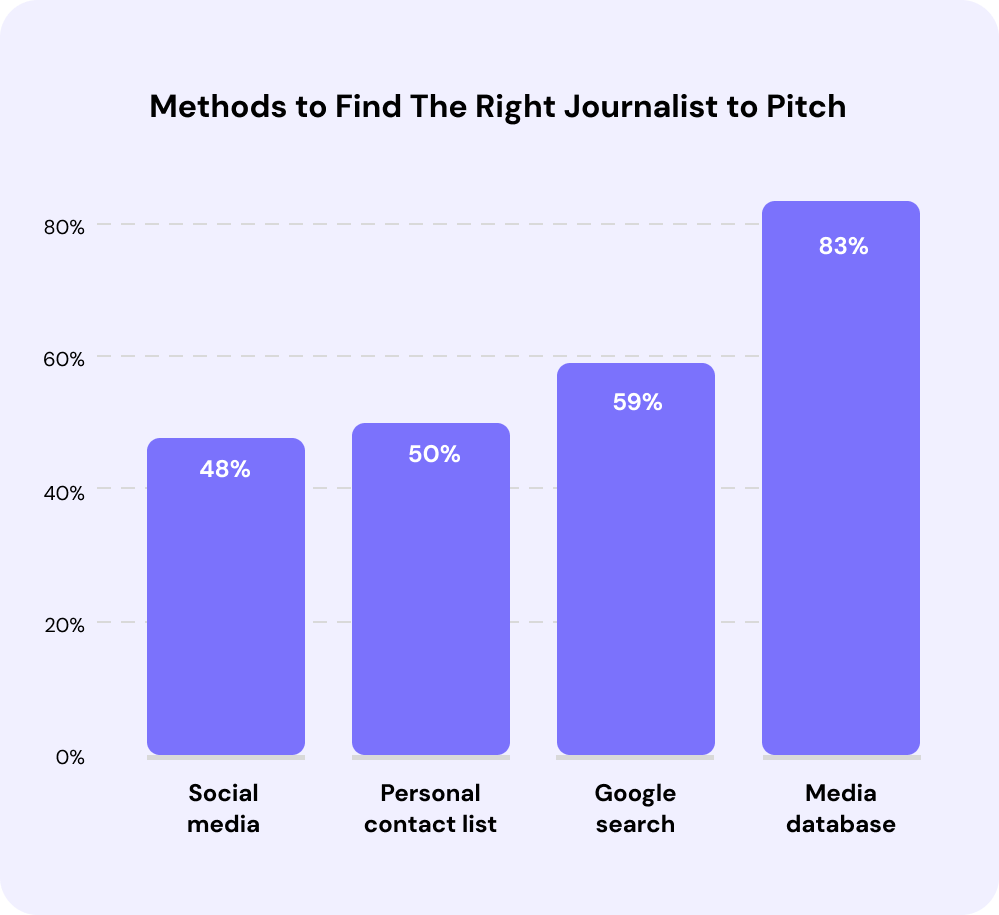










The primary PR communications challenge faced by 53% of agencies is the struggle to get responses from journalists, making it hard for them to communicate important messages and maintain a positive image.
55% of brands face resource constraints, including budget and personnel, which highlights the need for adequate resources to be allocated to PR activities to ensure effective communication strategies can be implemented.
Additionally, 40% of PR teams struggle to prove their worth to stakeholders and need to show the impact of their efforts to gain support and recognition.
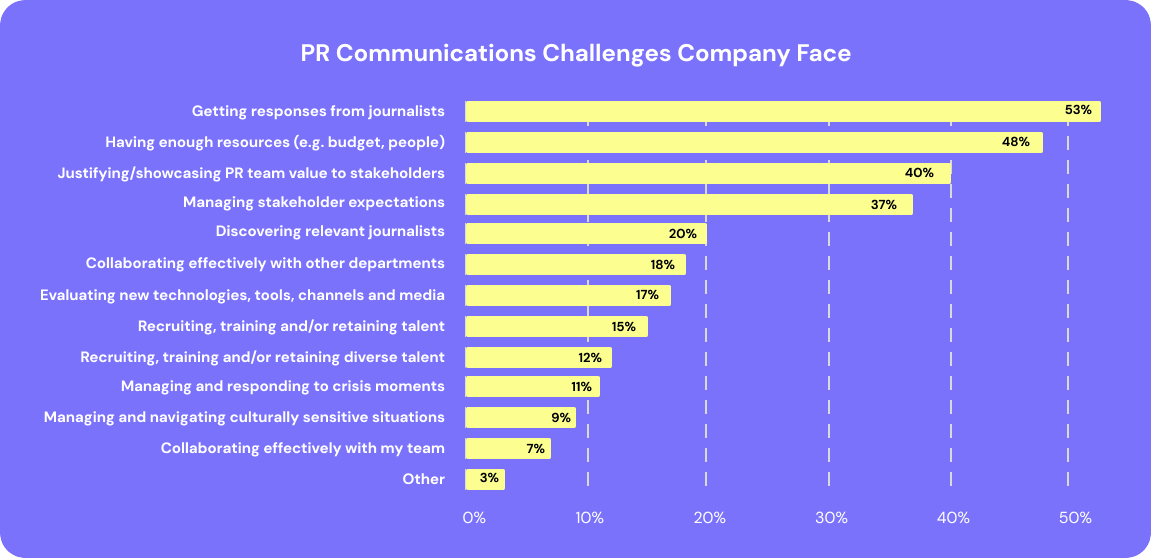
To enhance the value of their work for stakeholders or clients, the majority of PR professionals, around 66%, aim to produce measurable outcomes.
Additionally, approximately 62% emphasize linking PR efforts to important business objectives as the best way to increase the PR’s value.
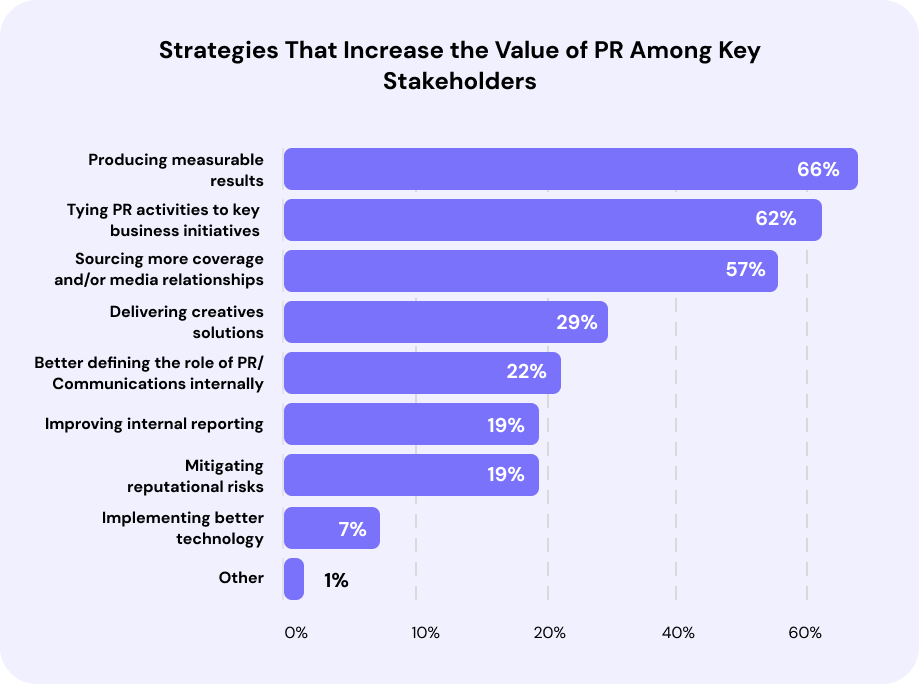
Social media has become an essential part of digital PR campaigns as they allow companies to reach a large audience quickly and easily. With millions of users on platforms such as LinkedIn, TikTok, and Instagram, companies can get their message in front of a vast number of people with just a few clicks.
And those are exactly what PR pros use to move their campaigns forward. 53% and 40% of them, respectively, have been utilizing LinkedIn and TikTok more frequently than before to advance their campaigns. On the contrary, they started using Facebook and Twitter less, as the data shows a decrease of around 25%.
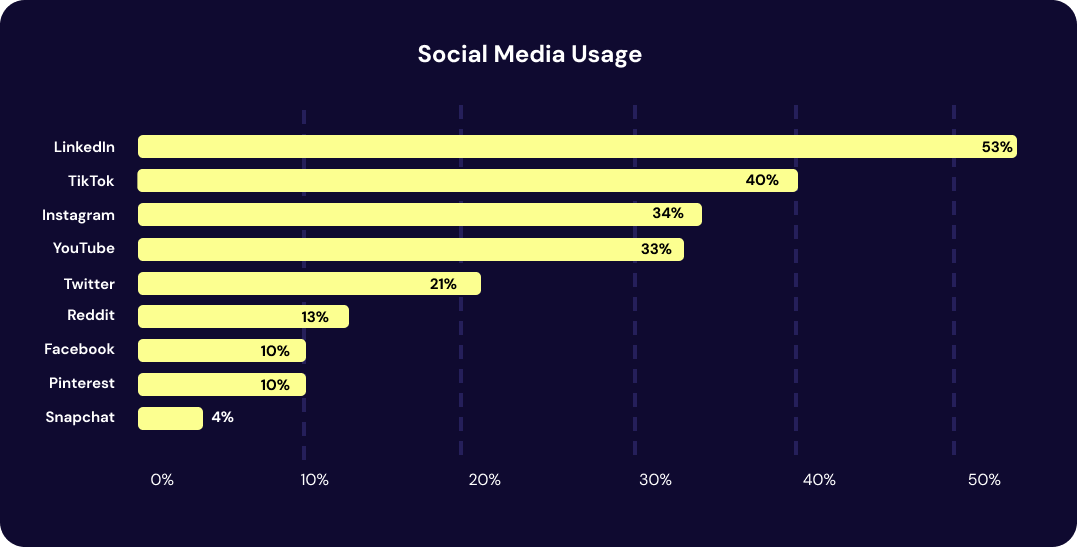
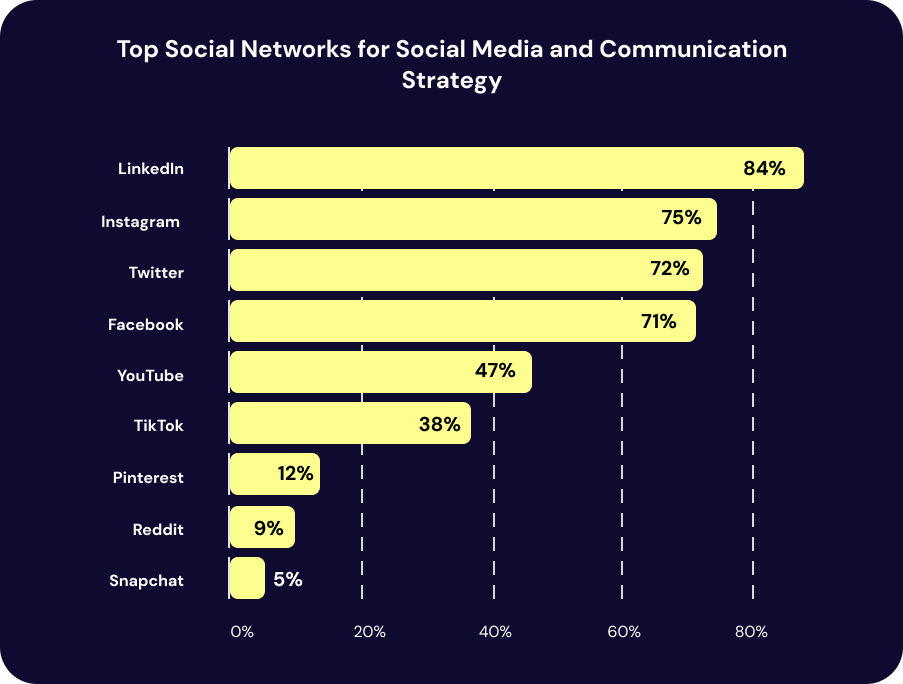
In the ever-evolving social media landscape, LinkedIn has emerged as the reigning champion of social networks for communication strategies, knocking Twitter off its throne.
LinkedIn is now the leading social network choice for 84% of digital PR professionals, recognizing its importance for networking and communication strategies. Instagram follows closely, with 75%, while Twitter and Facebook also rank high, at 72% and 71%, respectively.
With social media and online marketing becoming crucial for businesses to thrive, it’s essential for companies to analyze financial statistics and understand how much they’re investing in digital PR, how much revenue they’re generating, and how much profit they’re earning.
The way brands and agencies allocate their budget for digital PR varies. Recent data shows that agencies are ramping up their investment in this area, while many brands are likely to decrease their digital PR budget.
Once the budget is allocated, it is important to measure the success of that investment. Topping the list of the most useful metrics for measuring the success of public relations efforts is the “Number of stories placed,” indicating that the quantity and visibility of media coverage remain a primary indicator of PR success.
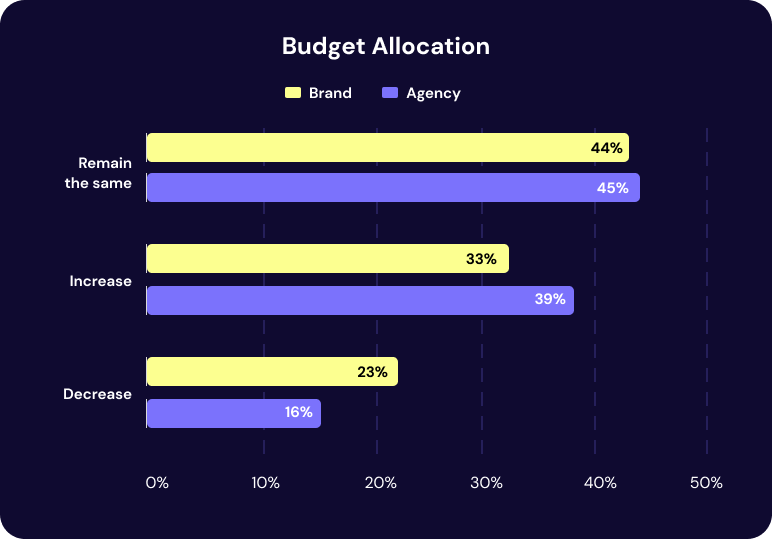
Following closely are “Reach/Impressions,” “Key message pull-through,” and “Website impact.” These metrics reflect and evaluate PR success, considering both the quantity and quality of media coverage, the effective delivery of key messages, and the impact on online presence and audience engagement.
The Most Useful Metrics to Measure PR Success




The next five years are poised to demand a heightened focus on a diverse set of skills for companies to thrive.
Among these is media relations, with 47% emphasized significance. A close second is strategic planning (46%), essential for navigating the complex and evolving business environment.
The growing importance of data and analytics (38%) underscores the need for organizations to leverage information effectively.
Embracing technological advancements, as indicated by the 31% emphasis on integrating new AI tools into workflow, is pivotal for staying competitive.
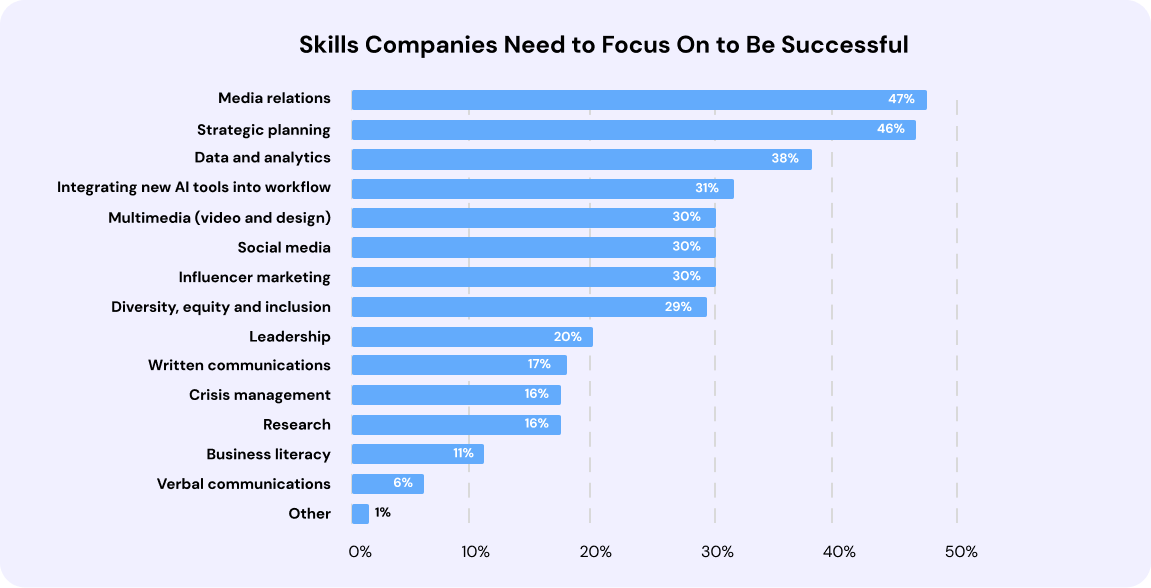
AI-powered tools and applications are rapidly changing the way PR professionals approach their work, from generating content to conducting research and data analysis.
According to research, around 61% of PR professionals reported using or planning to explore generative AI technology. Out of these, the C-suite level is the most likely to be utilizing it already.
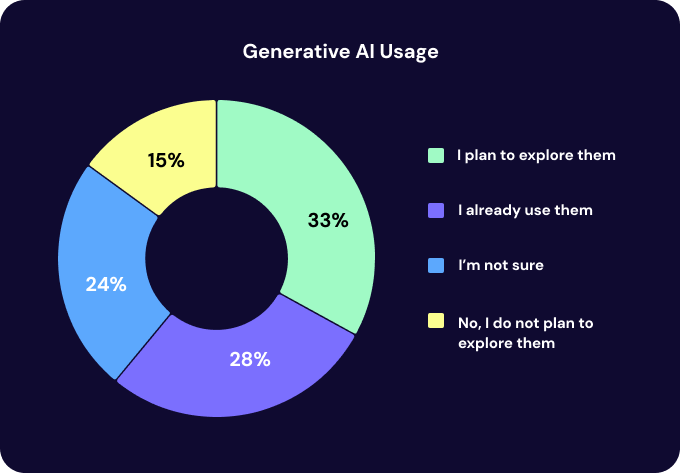
Many PR professionals are now using generative AI for various writing tasks. Some of the writing tasks that PR professionals are using generative AI for include crafting pitches, writing press releases, and writing social copy.
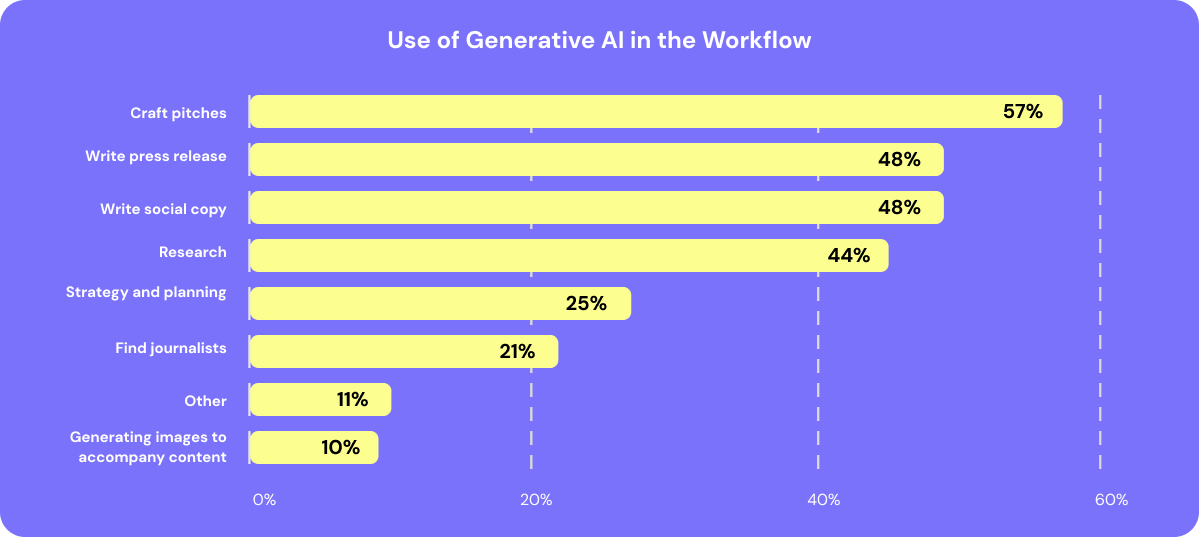
Even though AI is rapidly growing, there are still some concerns surrounding it. According to data, more than half of PR professionals are worried about using unexamined artificial intelligence output.
This is mainly because it can have a negative impact on younger or less experienced PR professionals and clients who think that AI can replace human content creators.
This concern is understandable because while AI can automate several PR tasks, it still lacks the creativity and empathy that human beings possess.
However, if used appropriately, AI can help PR professionals save time and effort, allowing them to focus on more strategic and creative aspects of their work.
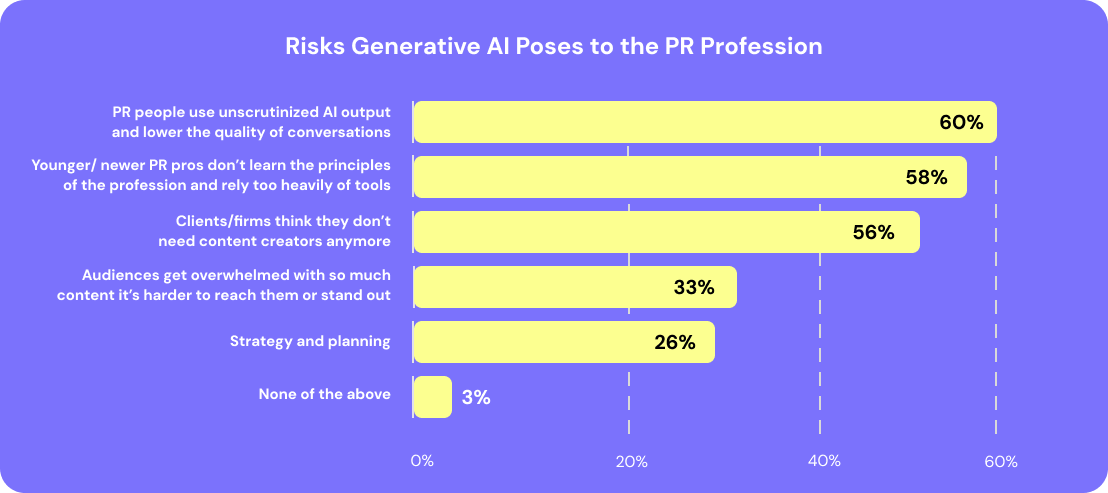
In the future, AI is poised to make significant impacts across various domains, with notable potential in research and list building, where it scores a high 68%. AI can process big data and identify patterns efficiently, which helps accelerate research and enhance data-driven decision-making.
Furthermore, monitoring and measuring tasks, at 54%, stand to benefit from AI’s prowess in real-time data analysis and predictive analytics, facilitating more accurate assessments and insightful observations.
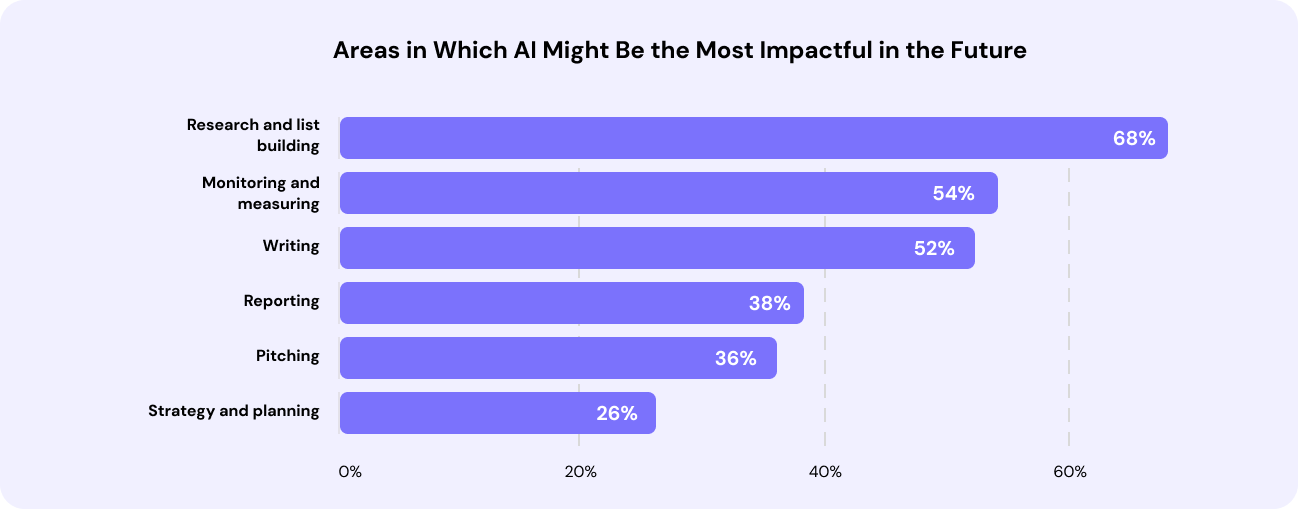
Digital PR has become an essential aspect of modern-day public relations.
With the rise of social media and other digital platforms, PR professionals must stay up-to-date with the latest statistics and trends to create targeted campaigns that resonate with their target audience and drive results.
Yet, it’s crucial to remember that digital PR constantly evolves, and professionals must adapt to the ever-changing landscape to stay relevant and successful.